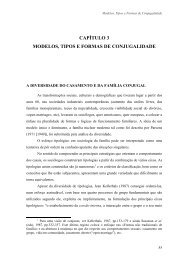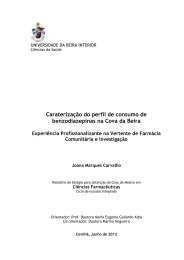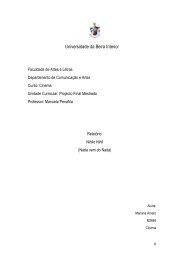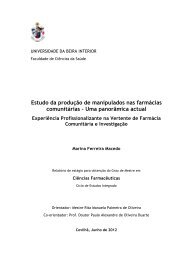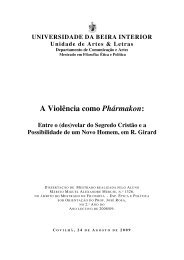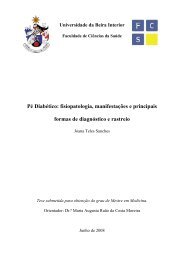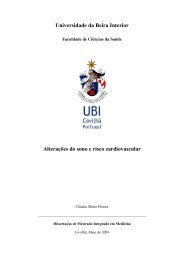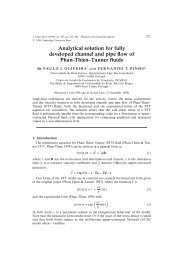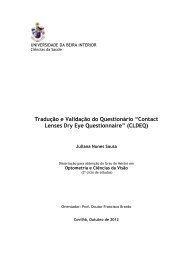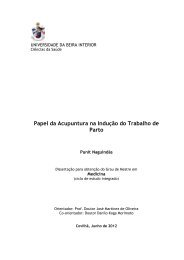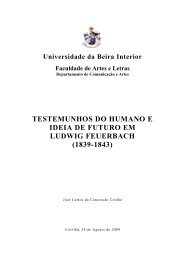Tese_Tânia Vieira.pdf - Ubi Thesis
Tese_Tânia Vieira.pdf - Ubi Thesis
Tese_Tânia Vieira.pdf - Ubi Thesis
Create successful ePaper yourself
Turn your PDF publications into a flip-book with our unique Google optimized e-Paper software.
Chapter III – Results and Discussion<br />
3.4. Evaluation of the antibacterial activity of the produced<br />
nanoparticles<br />
The antibacterial properties of the produced nanoparticles were evaluated against one<br />
bacterial strain a Gram-negative E. coli. The bacterial strain was deemed appropriate for testing<br />
the antibacterial properties of the nanoparticles since it has been reported to be the most<br />
common Gram-negative pathogen found in biomaterial-associated infections (Juan et al. 2010).<br />
The antibacterial effects of the produced nanoparticles were evaluated using the MIC and<br />
MBC, which are the standard microbiological procedures used to evaluate the bacteriostatic and<br />
bactericidal properties of antimicrobial agents.<br />
As already referred in the previous chapter, to determine MIC values, the nanoparticles<br />
were diluted 8 times with 100 µL of LB Broth inoculated with the tested bacteria at a<br />
concentration of 2.5×10 5 CFU/mL. The MIC was analyzed after 24 h of incubation, at 37 °C,<br />
based on culture turbidity. In cases where the nanoparticles affected the turbidity, rezazurin<br />
was used to determine the MIC value. The MIC was determined as the lowest concentration that<br />
inhibited the visible growth of the bacteria (Guzmán et al. 2009). Control bactericidal tests of<br />
chitosan and AgNO 3 solutions were also performed. To verify the reproducibility of the results,<br />
all antibacterial activity tests were performed in triplicate in three different days. The MBC was<br />
also determined by an imprinted method in an agar plate and it was also analyzed after 24 h of<br />
incubation, at 37 °C, based on the absence of colonies on the agar plate. The results of the tests<br />
of MIC and MBC of the nanoparticles against Gram-negative bacteria are listed in table 3 and 4,<br />
respectively. Figure 12 shows a representative experiment for the determination of the MIC and<br />
MBC.<br />
Table 3 – MIC obtained for the different tested nanoparticles.<br />
Materials tested<br />
MIC (µg/mL)<br />
Chitosan/Dextran nanoparticles 107.100<br />
Chitosan solution 62.500<br />
Chitosan/Dextran nanoparticles + AgNPs (NaBH 4 ) 1.500<br />
Chitosan/Dextran nanoparticles + AgNPs (C 6 H 8 O 6 ) 3.000<br />
Chitosan/Dextran nanoparticles + AgNO 3 + C 6 H 8 O 6 11.750<br />
Chitosan/Dextran nanoparticles + AgNO 3 + NaBH 4 23.500<br />
AgNPs (NaBH 4 ) 10.000<br />
AgNPs (C 6 H 8 O 6 ) >10.000<br />
AgNO 3 15.625<br />
39




